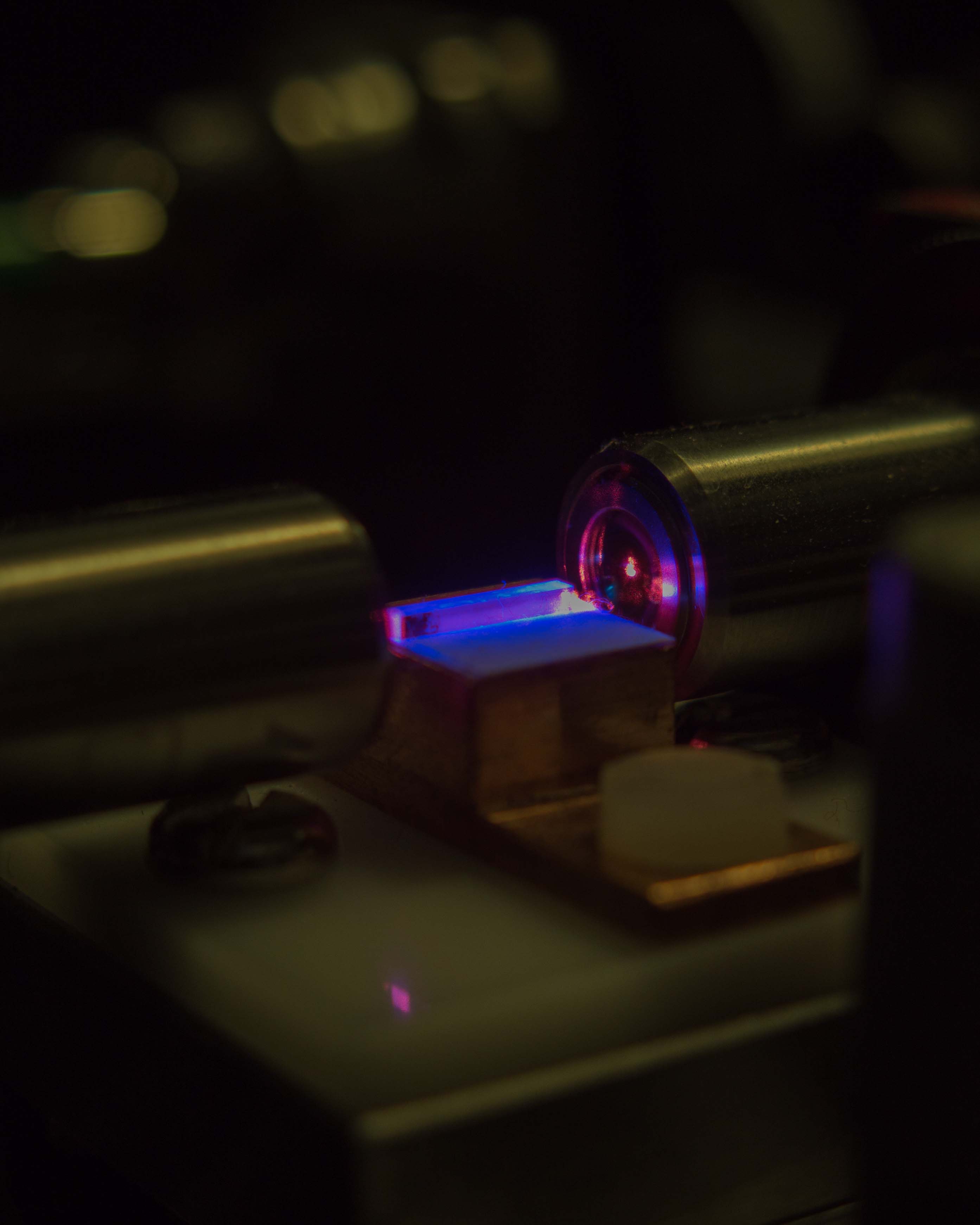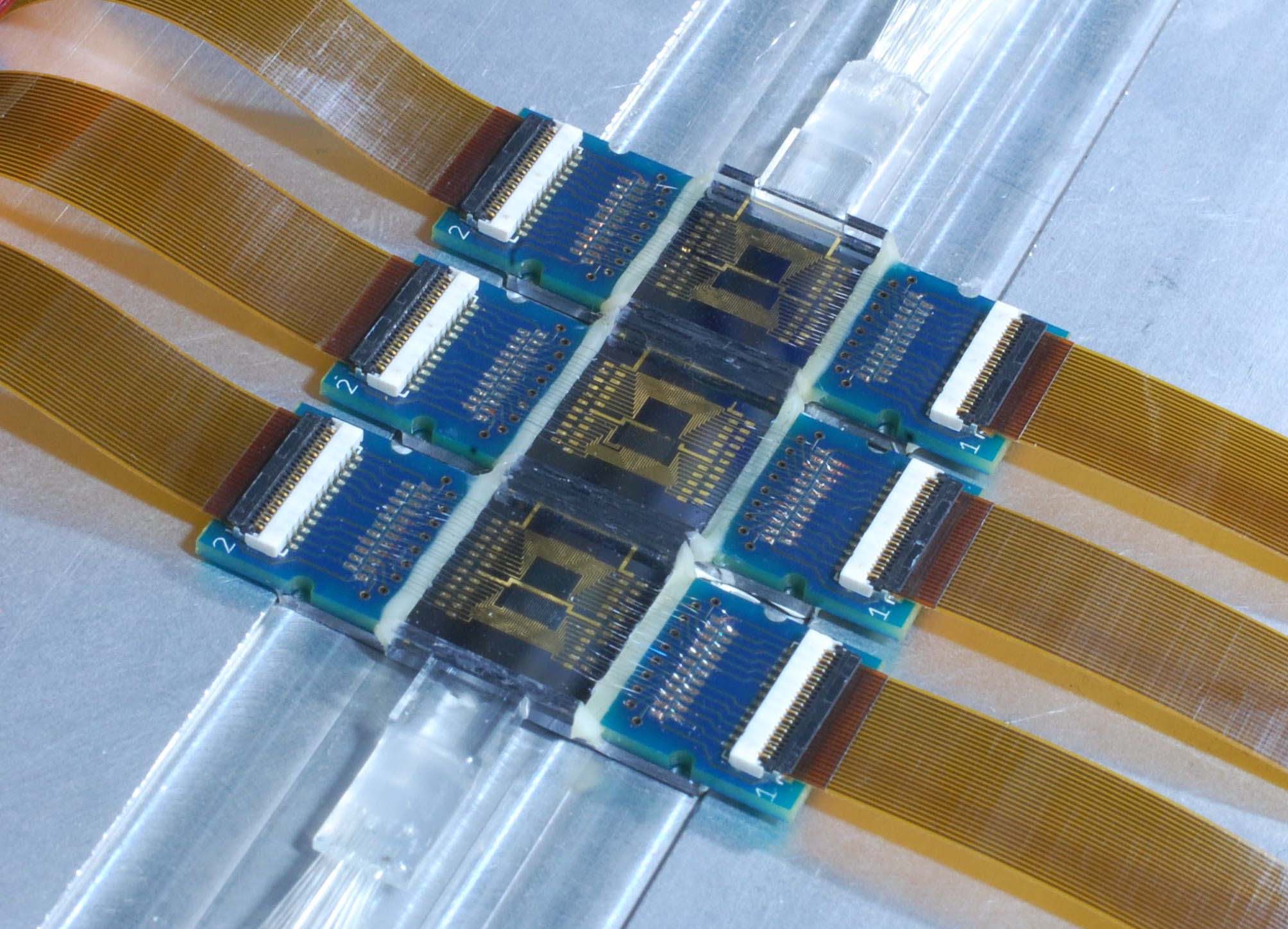NQIT Quantum Photography Competition - Round One
Optical FibresWe like to share our photons! Individual particles of light (photons), will likely form a key component of any quantum network. At Oxford we use optical fibres, such as these, to carry photons between different labs, but ultimately we would like to be able to share photons across the country, and around the globe. Each coloured “wire” contains a single tiny strand of glass fibre, only a few microns thick (1000 microns = 1 millimeter), which acts like a tunnel for the light to go down. |
|
Control Electronics for Superconducting Nanowire Single Photon DetectorsPhotons – single particles of light – are essential components of a quantum network, and an important goal for NQIT is to improve our ability to produce, manipulate and detect one photon at a time. However, most detectors (including our eyes!) are not very efficient, and only a few percent of the incident photons register a signal. In the lab we use high efficiency superconducting nanowire detectors which can (on average) detect 9 out of 10 photons. Superconductors have no electrical resistance, meaning that a current can persist for days without a battery. However, even a single photon can interrupt the current a thin enough wire – an effect which is very helpful for detecting photons! The picture shows the control electronics for monitoring the current in the 32 superconducting nanowire single photon detectors at Oxford. |
|
Light OvertonesThe rich sound of a human singing voice contains a blend of frequencies which are mathematically related, including wavelengths which are 1/2, 1/3, 1/4… etc. the wavelength of the main note that we hear. Well trained singers can even deliberately control which “overtones” they use! Light is also a wave, and while we hear different wavelengths of sound as separate pitches, we see wavelengths of light different colours. But unlike a beautiful voice, laser light normally only contains a single wavelength. By shining a laser through a non-linear crystal, we can add overtones of light to the laser beam. In the photo an invisible infrared laser (wavelength 770 nm) is shining through a crystal which transfers some of the energy into blue light (wavelength 385 nm – one “octave” higher). Non-linear processes such as this can create correlations in photon statistics, which could be the starting block for a quantum network. |
|
Quantum Photonic ChipsThese integrated chips are used to manipulate photons, individual particles of light, to perform quantum computation tasks. Photons are sent in and out of these chips via optical fibres on both sides of the chips, and gold wiring on the chip controls the path of these photons. |
|
Quantum Photonic ChipsThese integrated chips are used to manipulate photons, individual particles of light, to perform quantum computation tasks. Photons are sent in and out of these chips via optical fibres on both sides of the chips (at the top and bottom), and the path of these photons inside the chips is controlled by gold wiring on the chip that is connected to a computer via ribbon cables (left and right). |
|
Single Atom in an Ion TrapIn the centre of the picture, a small bright dot is visible – a single positively-charged strontium atom. It is held nearly motionless by electric fields emanating from the metal electrodes surrounding it. (The distance between the small needle tips is about two millimetres.) When illuminated with a specific shade of blue-violet laser light, the atom absorbs and re-emits photons sufficiently quickly for an ordinary camera to capture it in a long exposure photograph. This picture was taken through a window of the ultra-high vacuum chamber that houses the trap. Laser-cooled atomic ions provide a pristine platform for exploring and harnessing the unique properties of quantum physics. They are used to construct extremely accurate clocks or, as in our research, as building blocks for future quantum computers, which could tackle problems that stymie even today’s largest supercomputers. |
|
Atomic scale qubits and single electron transistors in a universal quantum computer surface code architectureScanning tunneling microscope (STM) hydrogen resist lithography on a silicon surface where the tip of the STM is used to locally remove individual hydrogen atoms. The exposed silicon areas are functionalized by dosing with phosphine. In this way, qubits that consist of a single phosphorus atom, single electron transistors (SETs) used for readout, as well as micrometer scale control lines (semi-transparent lines) can be realized. In the universal quantum computer surface code architecture each SET (diamonds, 10nm x 10nm) is accompanied by four qubits. The SETs and the qubits are arranged in a grid and addressed by control lines (schematically shown as semi-transparent lines) in planes above and below that are separated by epaxially grown silicon. This image (1000nm x 850nm) shows a proof-of-principle that the qubit/SET layer of the surface code architecture can be realized with STM hydrogen resist lithography. Note that, the entire structure is written on just two atomically flat terraces. |
|
The Single Pixel Camera from QuantIC in Glasgow, Scotland (UK)The Single Pixel Camera is a novel device which uses the small mirror array from inside a classroom digital projector and only one light sensitive pixel (photodiode) to capture low-cost real-time video at wavelengths beyond what we can see with our eyes. Shown is a prototype evolved from the University of Glasgow Optics Group’s research into ghost imaging, which relies on correlations between pairs of photons or light fields. At wavelengths other than the visible, the price of high resolution cameras is extortionate; however, with this camera, only a single cheap photodiode is necessary to image the likes of Short Wave Infrared. At these wavelengths, this device can see through smoke, tinted glass, underneath paintings and detect the presence of methane gas. This research has been conducted principally by Matthew Edgar, Graham Gibson and Miles Padgett, in association with QuantIC Quantum Technology Hub at the University of Glasgow (UK). |
|
Silicon Atoms for Quantum ComputingIn my research, I try to build quantum computers literally atom-by-atom. The image, taken using a Scanning Tunneling Microscope, shows hydrogen-passivated silicon surface. This means that single hydrogen atoms are bonded to silicon atoms, making the surface chemically stable. The height of features is related to the tunneling current at each point and depicts the position of silicon atoms in the crystal. Such perfectly reconstructed silicon chips are a host material for phosphorus atoms placed with atomic precision. Quantum information can be encoded onto the spins of electrons bound to those phosphorus atoms, allowing us to do quantum computation. This level of atomic control is only possible in ultra-high vacuum and is currently beyond the capabilities of modern microelectronics industry. To date, our lab is the only one in the world to be able to place atoms with this level of precision. |








